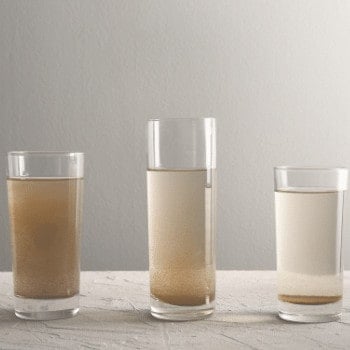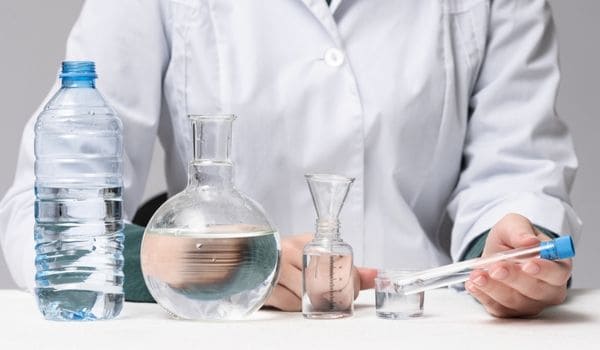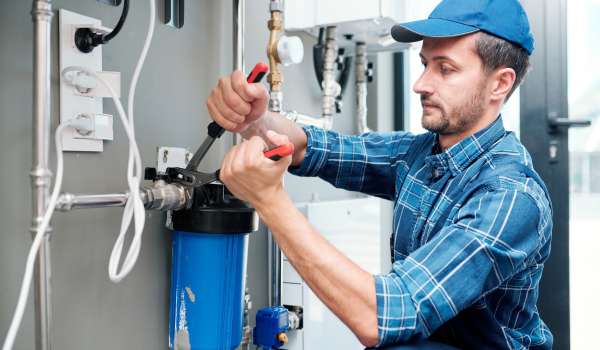If your water smells funny, stains your fixtures, or leaves your skin feeling off — you’re not alone. Millions of U.S. households rely on private wells, and many run into water quality issues at some point.
The good news? Most well water problems are completely fixable once you know what you’re dealing with. Whether it’s iron stains, weird taste, or hard water buildup, a little know-how (and the right filter) can go a long way.
Let’s break down the 9 most common well water problems — and exactly how to fix them.
⚡ Quick Take
- 🪨 Sediment – Cloudy water often points to dirt, rust, or sand sneaking into your well.
- 🥄 Iron & Manganese – Cause orange stains, metallic taste, and even slimy buildup.
- 💥 Bacteria – Invisible but serious; may lead to illness if untreated.
- 💦 Hardness – High calcium and magnesium levels cause scale buildup and appliance wear.
- 🥚 Hydrogen Sulfide – Rotten egg smell = sulfur gas.
- 🌫️ Tannins – Natural organics that give water a yellow tint.
- 🍋 Acidity – Low pH water corrodes pipes and leaches metals.
- ⚙️ Air or Methane – Tiny bubbles might be harmless — or worth a closer look.
- 🧪 Testing Is a Must – You can’t fix what you can’t identify.
🔎 What’s Causing Your Well Water Issues?

Not all well water problems are dangerous — but many can be frustrating, smelly, or downright expensive if ignored.
Whether it’s discoloration, strange odors, or mineral overload, the issues often come down to just a handful of culprits.
Here’s a snapshot of the most common problems and what they can do to your water:
| 🚩 Problem | 😬 What It Does | 🛠️ Fix It With |
|---|---|---|
| 🪨 Sediment | Clouds water, clogs pipes, damages appliances | Sediment filters or multi-stage systems |
| 🧲 Iron & Iron Bacteria | Rust stains, metallic taste, slimy orange buildup | Iron filters or chlorine injection |
| ⚫ Manganese | Dark discoloration, often alongside iron | Water softener or air-injection filter |
| 🍂 Tannins | Yellow tint from decaying plant matter | Carbon or anion exchange filtration |
| 🦠 Bacteria | Health risk — includes E. coli and coliforms | RO system, UV purifier, or chlorine injection |
| 🧱 Hard Water | Scale buildup, rough laundry, appliance damage | Water softener or TAC/NAC conditioner |
| 🧪 Acidic Water (Low pH) | Corrodes pipes, leaches harmful metals | Calcium carbonate acid-neutralizer |
| 💨 Hydrogen Sulfide | Rotten egg smell, corrosive to metal | KDF or oxidizing filters |
| 💭 Air or Methane | Cloudiness, bubbles — or explosive risk | Plumbing inspection and gas testing |
🔧 Why This Matters
Even small issues — like sediment or low pH — can snowball into stained fixtures, costly repairs, or reduced water pressure. And if bacteria or metals are part of the mix? That’s not just gross — it can affect your health.
💡 Bottom line: The sooner you figure out what’s in your water, the sooner you can fix it — and avoid damage down the line.
🛡️ How to Prevent Common Well Water Problems

The best way to fix a water problem? Don’t let it start in the first place. While not every issue is avoidable (Mother Nature has opinions), simple maintenance and smart habits can protect your well for the long haul.
Here’s how to stay ahead of the most common problems 👇
🧰 Stay on Top of Well Maintenance
Even a small issue — like a cracked casing or rusted screen — can let in sediment, bacteria, or surface runoff.
🔧 Do This Yearly:
- ✅ Inspect visible parts: pressure tank, well cap, jet pump
- 🔍 Look for cracks, leaks, or corrosion
- 🧰 Schedule a full inspection by a licensed well contractor
💡 Good to Know: Most well pumps last 10–15 years. Here’s how long your well pump typically lasts if you’re not sure when yours was installed.
🧪 Don’t Skip Annual Water Testing

You won’t always see a problem in your water — testing is how you catch hidden threats like nitrates, iron, bacteria, or acidity before they wreak havoc.
📋 The CDC recommends testing private wells once a year for:
- pH
- Nitrates
- Total Dissolved Solids (TDS)
- Coliform bacteria
🎯 Pro Tip: Need help? This well water testing guide breaks down what to test for and when.
🏡 Safeguard Your Well from Contaminants
Your wellhead is ground zero for protection — and a few smart habits can go a long way.
🌧️ If you live in a flood-prone area:
- Shut off your well power before water rises
- Seal the vented cap with a waterproof cover
🧯 Everyday protection tips:
- 💦 Install vacuum breakers on outdoor spigots to prevent backflow
- 🚫 Never dump chemicals, meds, or grease down drains
- 💀 Don’t bury animals or waste near your well (150+ feet away)
- 🌾 Keep fertilizers & pesticides far from the wellhead — and on a downhill slope if possible
🛑 Protect Your Well Like a Pro

Your well isn’t just a pipe in the ground — it’s your home’s water lifeline. And while filtration helps treat what’s already there, protection is your first defense against contamination.
Here’s how to keep your water source clean, safe, and disaster-resistant:
🧼 Everyday Best Practices
- 🔹 Dispose responsibly:Never pour chemicals, old meds, motor oil, or personal care products down the drain or toilet. They can leach into the groundwater and circle back through your well.
- 🔹 Watch where you bury things:Don’t bury animal remains, septic components, or waste within 150 feet of your well — even further if you’re on a slope.
- 🔹 Be chemical-smart: Mix fertilizers, pesticides, and herbicides well away from your wellhead — at least 150 feet, ideally on ground that slopes away from the well.
- 🔹 Add a vacuum breaker: A $10 backflow preventer for your outdoor spigots stops contaminated water (like pool or irrigation runoff) from reversing into your well line.
🌊 Flood-Ready Tips (Just in Case)
If your property is in a flood-prone zone, take these extra steps when water’s rising:
- 🧯 Shut off power to your pump — Running it during a flood can burn it out or draw contaminated water into the system.
- 🛡️ Seal the well cap — Replace the vented cap with a temporary waterproof one (or tightly wrap heavy-duty plastic over it) until floodwaters recede.
💡 Good to Know: A waterproof well cap won’t guarantee safety, but it can be the difference between minor cleanup and major contamination.
🧠 Final Thoughts
Well water problems aren’t rare — but the good news? Most are fixable, and some are even preventable with the right tools and habits.
Whether it’s rust stains, cloudy water, strange smells, or pump pressure problems, every issue on the list has a solution — and often, more than one. With a little testing, smart filtration, and some basic well TLC, clean water is completely within reach.
💡 Here’s the bottom line:
- ✔️ Test annually — It’s the only way to know what’s really in your water.
- ✔️ Filter smart — Don’t guess. Match the system to your needs.
- ✔️ Maintain your well — A small checkup today can prevent a big mess later.
- ✔️ Protect your water source — It’s easier to stop contamination than fix it.
With a few simple steps, your well water can be as clean, clear, and trustworthy as any municipal supply — maybe even better.
 165 people found this helpful. Was this guide helpful to you?
165 people found this helpful. Was this guide helpful to you? 

